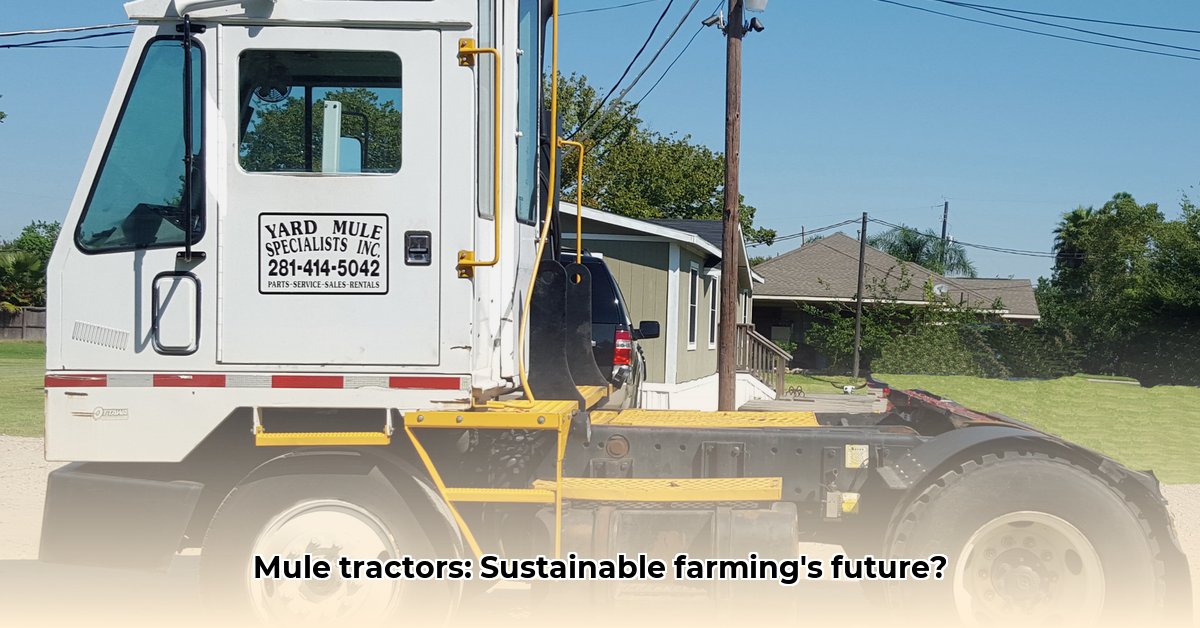
Mule Tractors: Your Sustainable Farming Partner
Sustainable agriculture demands efficient, environmentally friendly equipment. Mule tractors, compact and maneuverable machines, are emerging as a key player in this shift. Their smaller size and fuel efficiency offer a compelling alternative to larger tractors, particularly for smaller farms or specialized tasks. For more on electric options, check out this resource on electric garden tractors. This article explores how mule tractors contribute to sustainable farming, provides a cost analysis, offers a practical guide to selection and use, and looks towards future trends.
Mule Tractors in Sustainable Farming
Mule tractors contribute to sustainability in several ways:
- Reduced Environmental Impact: Their smaller size and lower fuel consumption lead to reduced greenhouse gas emissions compared to larger tractors. This translates to a smaller carbon footprint for your farm.
- Ideal for Smaller Farms and Specific Tasks: Mule tractors excel in environments where larger machinery is impractical, like vineyards, orchards, and smaller fields. Their maneuverability allows access to tight spaces and reduces soil compaction.
- Fuel Efficiency: Mule tractors significantly reduce fuel costs compared to larger models, contributing to both economic and environmental sustainability.
While data directly comparing the reduced enviromental impact of mule tractors to larger tractors is still emerging, the inherent fuel efficiency and reduced soil compaction associated with their use strongly suggests a positive environmental contribution. Ongoing research is exploring these impacts in greater detail.
Assessing the Cost-Effectiveness of Mule Tractors
The cost-effectiveness of a mule tractor depends on multiple factors. While the initial purchase price is typically lower than a large tractor, total cost of ownership should be considered. This includes fuel, maintenance, potential repairs, and the lifespan of the machine.
A simplified comparison shows potential savings:
| Factor | Mule Tractor | Large Tractor |
|---|---|---|
| Initial Purchase Price | Significantly Lower | Significantly Higher |
| Fuel Consumption | Substantially Lower | Substantially Higher |
| Maintenance Costs | Generally Lower, Simpler Repairs | Generally Higher, More Complex Repairs |
| Repair Costs | Potentially Lower | Potentially Higher |
The long-term cost savings depends on factors like usage intensity, terrain, and specific models. A thorough analysis tailored to your farm's needs is essential. Consider calculating the cost per hour of operation for both mule and larger tractors to understand the overall long-term value proposition.
Practical Guide to Choosing and Using Mule Tractors
Choosing and effectively using a mule tractor requires careful planning:
- Assess Your Farm's Needs: Define the tasks the tractor will perform (e.g., tilling, hauling, spraying). Consider field size, crop types, and terrain challenges.
- Set a Budget: Account for initial purchase price, ongoing maintenance, fuel, repairs, and potential add-ons (attachments or upgrades).
- Research and Compare Models: Explore different brands and models, focusing on horsepower, payload capacity, and available attachments. Consider factors such as warranty and dealer support.
- Prioritize Safety: Always follow the manufacturer's safety guidelines. Use appropriate safety equipment, including a seatbelt, and be aware of your surroundings.
Maintenance Best Practices:
- Regular Fluid Checks: Regularly check and maintain proper levels of engine oil, transmission fluid, and coolant.
- Tire Care: Inspect tires for wear, tears, or improper inflation before each use.
- Cleaning and Lubrication: Regular cleaning and lubrication of moving parts will extend the tractor's service life.
Consistent maintenance is vital for extending the lifespan of your mule tractor and maximizing its efficiency.
Enhancing Efficiency with Upgrades and Add-ons
Mule tractors offer significant flexibility. Upgrades can further enhance efficiency:
- Specialized Implements: Add implements tailored to specific tasks, including tillers, sprayers, or small trailers. This versatility increases the utility of the single machine.
- Technological Integration: Consider GPS integration for precision farming, improving the accuracy and effectiveness of tasks like planting or fertilization.
These add-ons significantly increase the mule tractors capabilities and overall farm efficiency.
Future Trends and Innovations
The future of mule tractors is promising:
- Improved Fuel Efficiency: Expect further advancements in engine technology, potentially including hybrid or electric models, further reducing environmental impact.
- Automation: Automation features, such as autonomous driving or precision guidance systems, could improve efficiency and reduce labor costs.
Technological advancements will likely reshape the capabilities of mule tractors and their role in sustainable agriculture. However, the cost-effectiveness and practicality of these developments require further observation and investigation.
Conclusion
Mule tractors offer a compelling blend of sustainability and efficiency for modern farming. Their reduced environmental footprint, cost-effectiveness, and versatility make them ideal for numerous farming operations. While they might not replace large tractors entirely, mule tractors fill a critical niche in the transition to sustainable agriculture, particularly for smaller farms and specialized tasks. Carefully consider your specific farm needs when making an investment decision. The ideal choice depends entirely on individual farm circumstances.